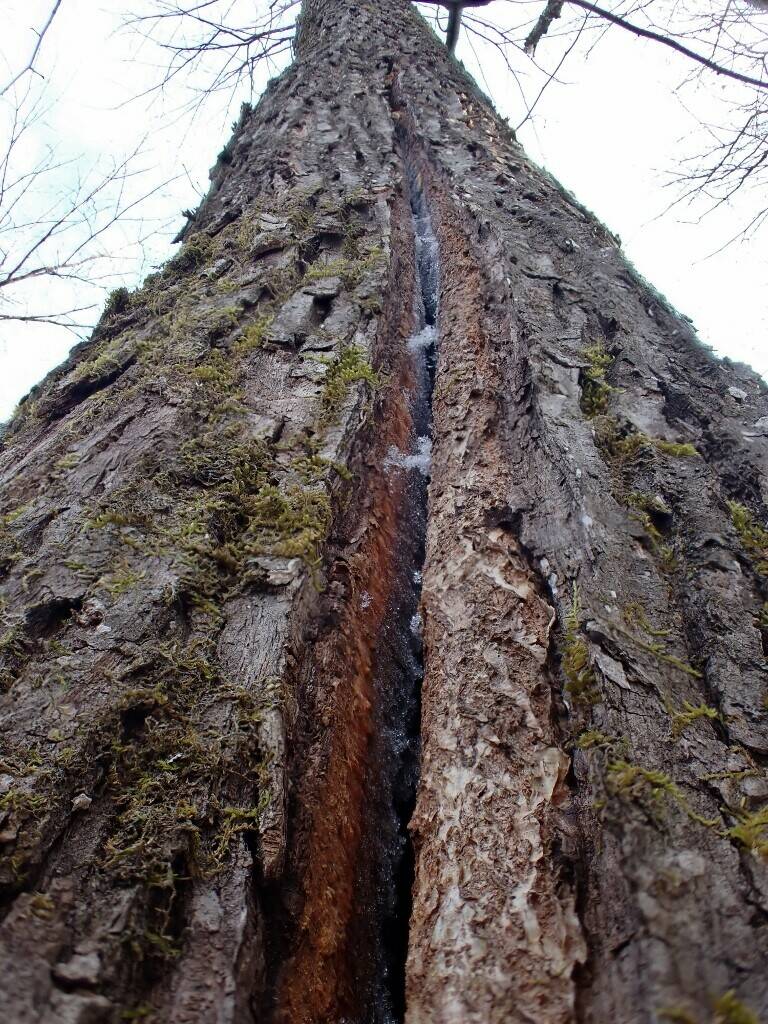News & Articles
Browse all content by date.

Some previous injury weakened this young basswood tree, and then plummeting temperatures caused it to crack open with a sound like a rifle shot. Photos by Emily Stone.
I opened my garage door and gazed out toward the setting sun over an expanse of snow-covered ice.
Strange, I thought. The lake level must have risen, since the ice was now level with the sill.
Turning to the right, my heart jumped when I saw two young polar bears playing in the snow just meters away. They were white, fluffy, and cute. Although their body shape was wrong. Maybe they were albino black bears?
In any case, they paid me no mind, and seemed to present no danger. But, where was their mother?
Then CRACK! A sound like a rifle shot reverberated through the air.
I awoke with a start and opened my eyes to the dark room. The bears had been in my dream (where did that come from?), but the sound was from real life.
I fumbled through a sleepy haze to understand the noise. Was the house falling apart? No, there were no other sounds of destruction or chaos. Then, obviously, it must have been a tree cracking open in the cold.
I checked my phone: 3:30 a.m. I opened my weather app and checked the temperature: -13 degrees Fahrenheit and falling.
Outside, a full moon cast shadows in the brittle cold.
“Sweet,” I thought to myself as I roll-ed over, “now I know what to write about this week.”
The thermometer read -18 degrees when I came downstairs to make cof-fee. This had been one of the coldest nights of the winter so far, and it fol-lowed on the heels of a really lovely, clear, sunny afternoon.
At one point I had turned my face to the sun and reveled in the warmth I felt – even though the high temperature only reached 11 degrees above zero.
My face wasn’t the only thing absorbing warmth. The low-angled rays of afternoon sun were beaming their energy onto the southwest sides of trees. This heats up the bark and the inner wood. When things warm, they expand.
The other side to that, of course, is that as the Earth’s heat escaped into a cloudless night and temperatures plummeted, the wood contracts rapidly and unevenly, with the outer layers showing the most dramatic change. The contrast is divisive, and the sound of wood ripping apart is loud.
Even as it burst into my dreams, the past night’s crack had sounded close.
So, once the temperature rose above zero, I layered up and decided – without much hope – to see if I could find the tree who split.
Standing under my bedroom window, I turned to look northeast – at the southwest sides of the trees – the side that usually cracks. Sure enough, there were at least a half-dozen narrow scars snaking lengthwise up trunks. On ashes, maples, and hemlocks, these cracks had all been trying to heal themselves for years if not decades. These were good evidence of past frost cracking.
On snowshoes, I took a little tour of the scars. They were filled with rough bark, old mushrooms, beetle-hole-riddled wood, piles of sawdusty larval frass, crusty specks of wound-healing pitch, and the messy webs of now-frozen spiders.
Wonderful stuff, really. These old tree scars are fun to explore!

When this frost crack opened, humid air inside the wood made contact with frigid temps and hoarfrost crystals grew.
As I came full circle, though, the black stripe of a narrower crack caught my eye. It was on the southwest side of a young basswood tree – less than a foot in diameter – and just beyond my bedroom wall. Close up, I found none of the scar tissues or evidence of age I’d seen in the other scars. Instead, I found the warm brown colors of bark that hasn’t been weathered. I found small slivers of creamy wood – freshly exposed. And I found a deep crevasse filled with glittering crystals of hoar frost – assembled from moisture recently released from damp wood.
Radial cracks like this one – fissures that dive inward to the tree’s core instead of just separating inner bark from outer bark – are associated with injuries sustained in the tree’s youth.
Did some piece of equipment scrape against this young basswood 20 years ago as the house was being built? The injury creates an area of weakness, and an entry for decay. Bacteria and fungi move in, and as they decompose the wood it absorbs extra moisture. The defective wood doesn’t expand and contract as well as healthy wood, and rapid freezing finally bursts open a significant crack. CRACK!
Warm weather will allow the wood to relax and close the crack again. The tree will begin to build scar tissue around the injury. And maybe, with quieter nights, I’ll get to enjoy the antics of those polar bear cubs.
Emily Stone is the Naturalist/Education Director at the Cable Natural History Museum. Her award-winning second book, Natural Connections: Dreaming of an Elfin Skimmer, is now available to purchase at cablemuseum.org/books. For more than 50 years, the Cable Natural History Museum has served to connect you to the Northwoods. The Museum is closed, but our Mysteries of the Night exhibit is available online.
Connect with us on Facebook, Instagram, YouTube, and cablemuseum.org to keep track of our latest adventures in learning.
| Tweet |


